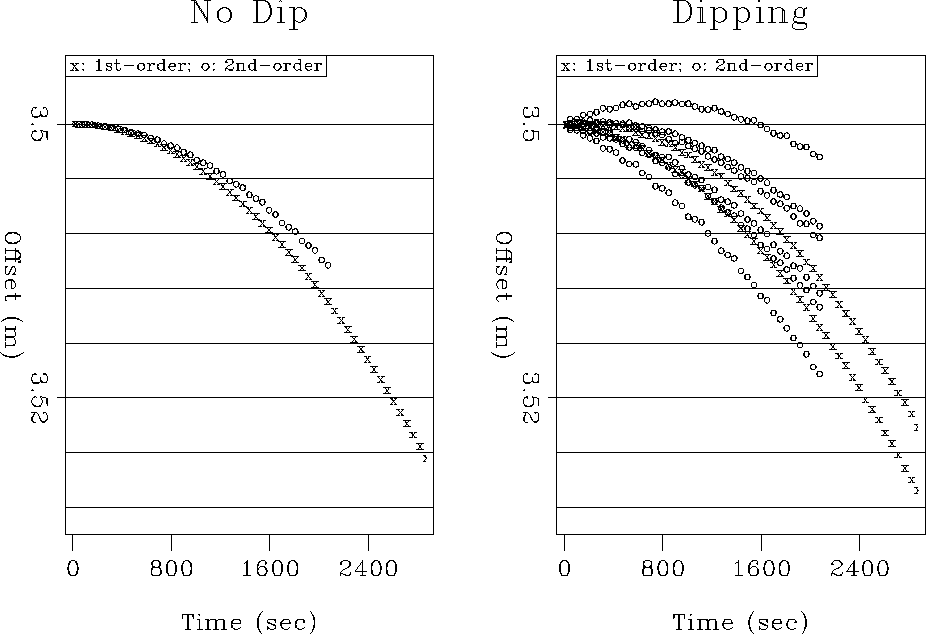




Next: Regularization 2: Differencing across
Up: The LSJIMP Inverse problem
Previous: Regularization of the LSJIMP
Corresponding signal events on all  are focused at a
single
are focused at a
single  for all x, and by design, have directly comparable amplitudes.
Conversely, corresponding crosstalk events on two model panels (e.g. residual
first-order multiples on
for all x, and by design, have directly comparable amplitudes.
Conversely, corresponding crosstalk events on two model panels (e.g. residual
first-order multiples on  and residual second-order multiples on
and residual second-order multiples on
 ) generally have different residual moveout. While the exact
magnitude of the moveout differences depend on the choice of imaging operator,
Figure 1 illustrates that they generally are small at
near offsets, but more pronounced in the presence of subsurface complexity, and
at far offsets/reflection angles.
crossdiff2.gulf
) generally have different residual moveout. While the exact
magnitude of the moveout differences depend on the choice of imaging operator,
Figure 1 illustrates that they generally are small at
near offsets, but more pronounced in the presence of subsurface complexity, and
at far offsets/reflection angles.
crossdiff2.gulf
Figure 1 Comparison of crosstalk events on primary
and first-order multiple images, for my particular choice of multiple imaging
operator. ``X'' indicates position of split first-order pegleg on primary
image,  . ``o'' indicates position of the three second-order pegleg
events on both
. ``o'' indicates position of the three second-order pegleg
events on both  and
and  . Left panel is with no
subsurface dip, right has seabed and target reflector dip of
. Left panel is with no
subsurface dip, right has seabed and target reflector dip of  . With
no dip, corresponding crosstalk events have little differential moveout. A
small amount of dip quickly increases differential moveout.
. With
no dip, corresponding crosstalk events have little differential moveout. A
small amount of dip quickly increases differential moveout.





We therefore conclude that at fixed  , the difference between two
, the difference between two
 will be relatively small where there is signal, but large where
there is crosstalk noise. We now write this difference as a model residual:
will be relatively small where there is signal, but large where
there is crosstalk noise. We now write this difference as a model residual:
| ![\begin{displaymath}
\bold r_m^{[1]}[j](\tau,x) = \bold m_j(\tau,x) - \bold m_{j+...
...),
\hspace{0.1in} \mbox{where} \hspace{0.1in} j=[0,p(p+3)/2].\end{displaymath}](img31.gif) |
(7) |
p is the maximum order of multiple included in equation (2).
Here I have modified the notation a bit and written  rather than
rather than
 because the difference (7) is blind to the
order or leg of the pegleg corresponding to
because the difference (7) is blind to the
order or leg of the pegleg corresponding to  ; it is simply a straight
difference across all the model panels.
; it is simply a straight
difference across all the model panels.
As mentioned early in this thesis, a central motivation for LSJIMP is the desire
to combine information from the multiple and primary images by averaging. In
addition to discriminating against crosstalk, equation (7)
provides a systematic framework for this averaging. If a signal event on one
image is obscured by noise, the noise may not be present on an adjacent image,
and equation (7) will attenuate it. This regularization
enforces a degree of smoothness and consistency between images.





Next: Regularization 2: Differencing across
Up: The LSJIMP Inverse problem
Previous: Regularization of the LSJIMP
Stanford Exploration Project
5/30/2004


![]() , the difference between two
, the difference between two
![]() will be relatively small where there is signal, but large where
there is crosstalk noise. We now write this difference as a model residual:
will be relatively small where there is signal, but large where
there is crosstalk noise. We now write this difference as a model residual: